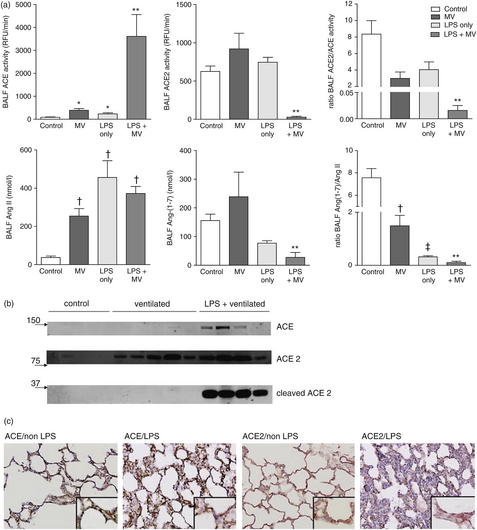Critical Care Medicine
Adult Critical Care
Acute respiratory distress syndrome leads to reduced ratio of ACE/ACE2 activities and is prevented by angiotensin-(1–7) or an angiotensin II receptor antagonist
Wösten-van Asperen RM, Lutter R, Specht PA, et al (Emma Children’s Hosp/Academic Med Centre, Amsterdam, The Netherlands; Academic Med Centre, Amsterdam, The Netherlands; Erasmus Med Centre, Rotterdam, The Netherlands; et al) J Pathol 225:618-627, 2011§
Evidence Ranking
• C
Expert Rating
• 3
Abstract
Acute respiratory distress syndrome (ARDS) is a devastating clinical syndrome. Angiotensin-converting enzyme (ACE) and its effector peptide angiotensin (Ang) II have been implicated in the pathogenesis of ARDS. A counter-regulatory enzyme of ACE, ie ACE2 that degrades Ang II to Ang-(1–7), offers a promising novel treatment modality for this syndrome. As the involvement of ACE and ACE2 in ARDS is still unclear, this study investigated the role of these two enzymes in an animal model of ARDS. ARDS was induced in rats by intratracheal administration of LPS followed by mechanical ventilation. During ventilation, animals were treated with saline (placebo), losartan (Ang II receptor antagonist), or with a protease-resistant, cyclic form of Ang-(1–7) [cAng-(1–7)]. In bronchoalveolar lavage fluid (BALF) of ventilated LPS-exposed animals, ACE activity was enhanced, whereas ACE2 activity was reduced. This was matched by enhanced BALF levels of Ang II and reduced levels of Ang-(1–7). Therapeutic intervention with cAng-(1–7) attenuated the inflammatory mediator response, markedly decreased lung injury scores, and improved lung function, as evidenced by increased oxygenation. These data indicate that ARDS develops, in part, due to reduced pulmonary levels of Ang-(1–7) and that repletion of this peptide halts the development of ARDS (Figs 2 and 4).
Stay updated, free articles. Join our Telegram channel

Full access? Get Clinical Tree




